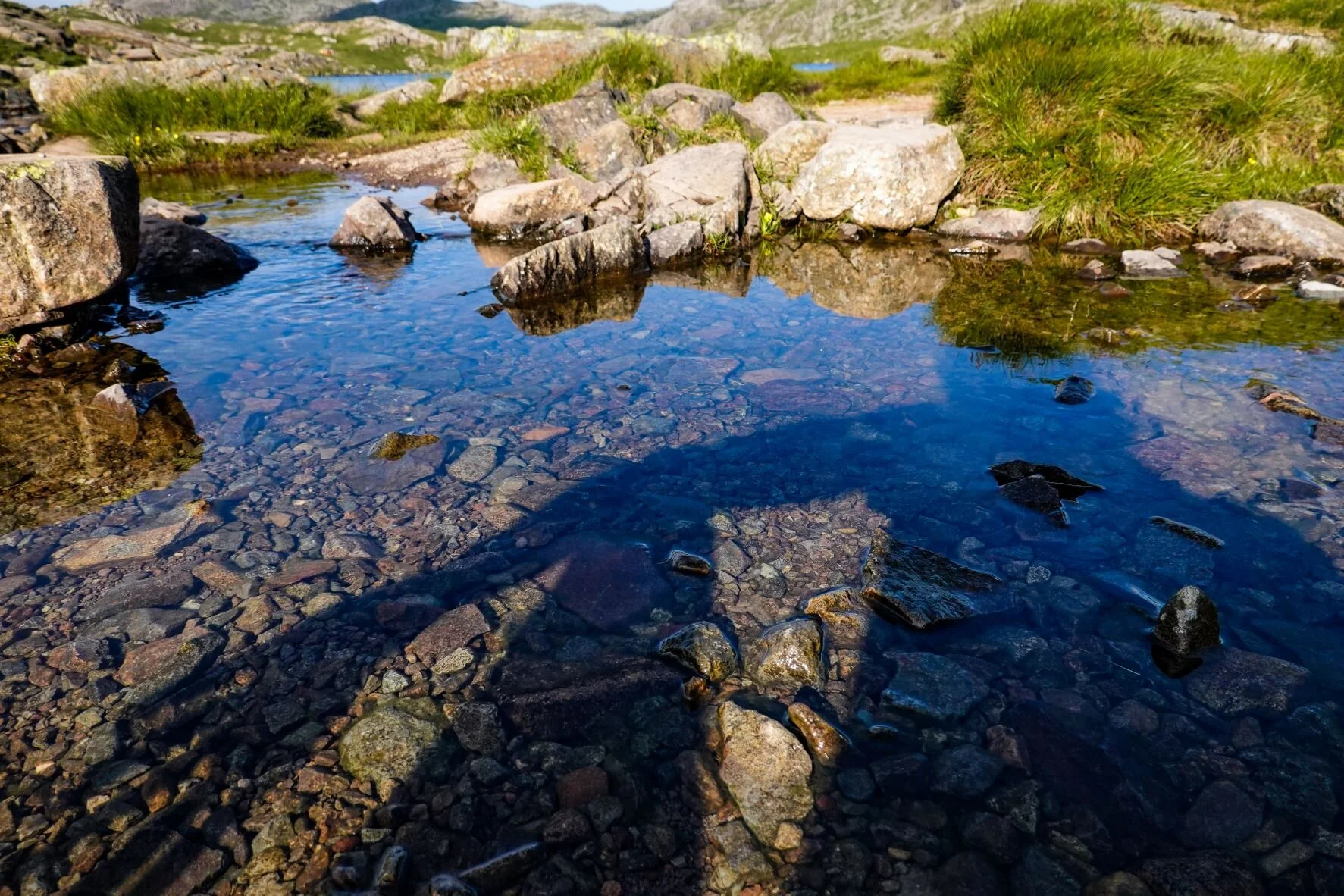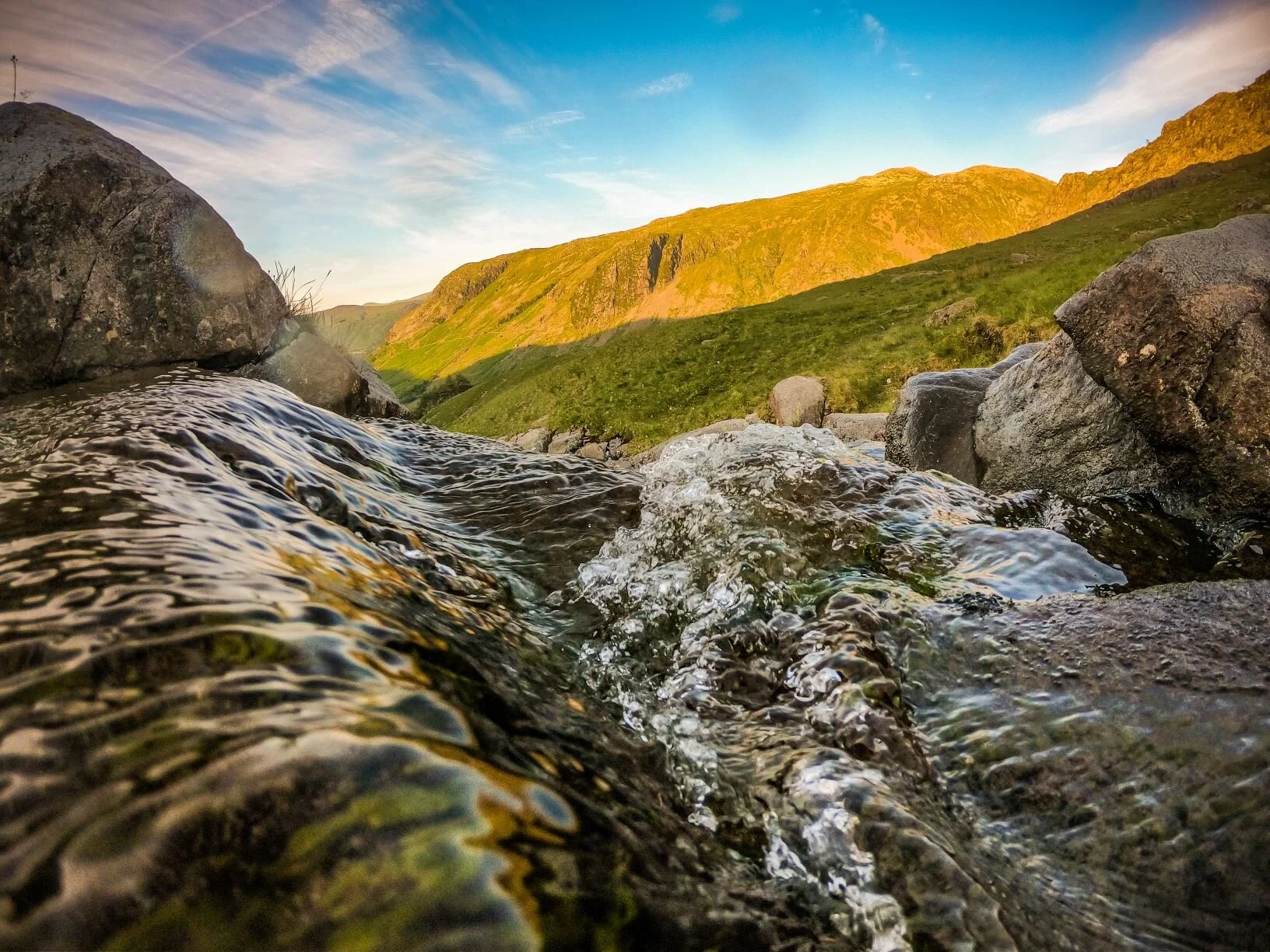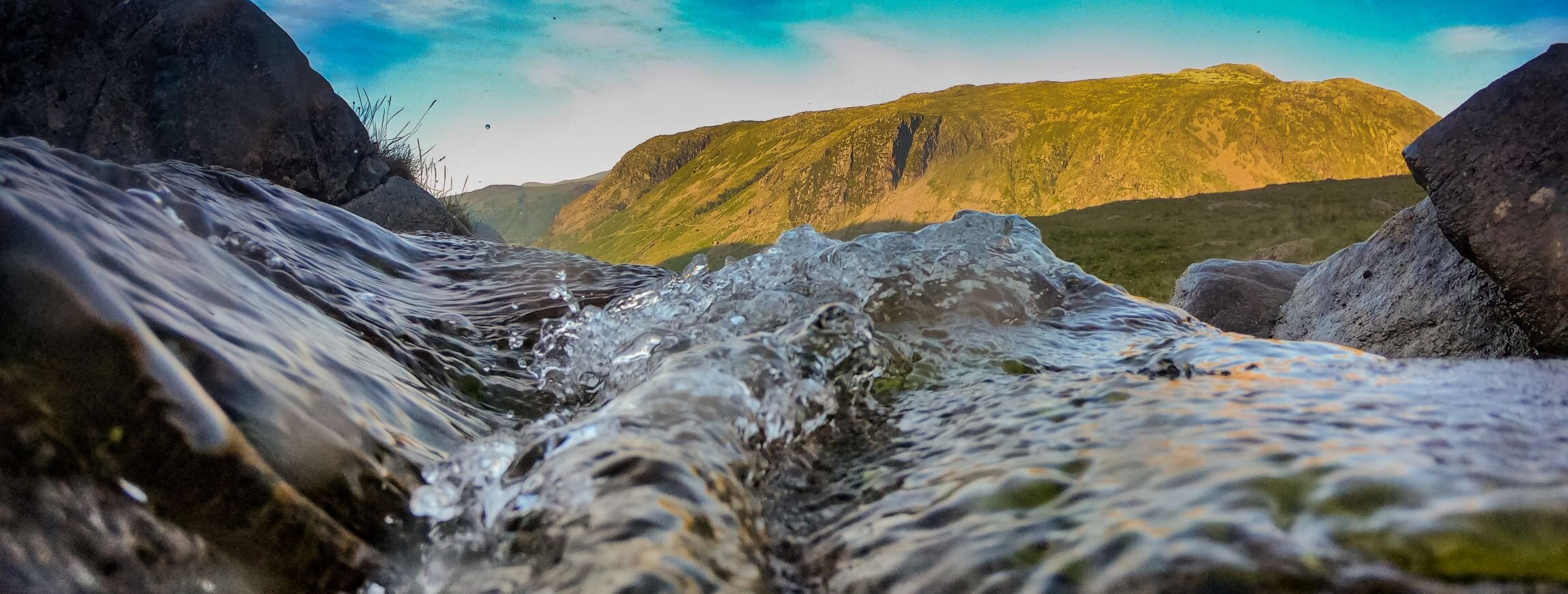Thinking as Water: the River Derwent
Aim
To think as water thinks during a walk (plus swim if you like) along the River Derwent (or any other watercourse) from source to sea as a means of gaining insight into broader environmental questions. To encourage us to move away from the binary ways of thinking which assume that the ‘natural world’ is here to serve our needs, and to realise that we are a smaller part of the picture than we usually assume.
This experiment has been developed in collaboration with Harriet Tarlo, author of eight poetry books, four artists’ books (with visual artist Judith Tucker), and editor of the renowned eco-poetry anthology The Ground Aslant: Radical Landscape Poetry Anthology (Shearsman 2011). She is Professor of Ecopoetry and Poetics at Sheffield Hallam University.
Background
There is a hierarchy of being in how we think about the more-than-human world. We tend to relate more easily to mammals, but when we get down to insects and fish it becomes harder to identify with them. This experiment focusses attention upon this dynamic by inviting us to radically flip our perspective; how might it be if we were to not only think of the element of water as a sentient living being, but to think as it? Once we start thinking as water, might we start becoming more aware of all the other systems in which the water participates? With land management practices. With the weather. With habitat, flora, stones. During this process, it’s proposed that the notion of respect becomes key; as we start to think from a water perspective rather than a human one, we become more aware of the effect of every little action that we make. For, of course, what the water and we desire are not the same thing.
Cockermouth: underwater
This experiment also seeks to help us to think about climate change and pollution. Climate change is notoriously difficult to write about, since the phenomenon itself is of such a large scale, and yet is not accessible directly to our senses (ie it has elements of the sublime). By encouraging you to think as a river, we provide a way in…The River Derwent was specifically chosen since Styhead (whose tarn the River Derwent runs through) is renowned to be the wettest place in England with 4,391mm of annual rainfall, and Seathwaite (further downstream) the wettest inhabited place. Furthermore, despite being a fairly short river, it’s one which makes its impact felt along its way: the catastrophic Cockermouth floods of 2009 and 2015 resulted from the combination of unusually heavy rainfall, quick run-off of water from the fells, and an exceptionally high tide causing the rivers Derwent and Cocker to burst their banks where they converge in the centre of the town. During its 60 mile length, the Derwent also passes through a contrasting range of landscapes, from the Lakeland mountainscapes around Sprinkling and Styhead Tarns (we swear that the best view of Scafell Pike is from the centre of the latter), to the softer more verdant agricultural landscape north west of Bassenthwaite, to its exit into the sea in the post-industrial context of Workington port.
Route instructions
Click on the image above to open an interactive version of the map on Viewranger,
or you can download the GPX file of my route here (© OpenStreetMap contributors)
Route: Medium (6.12 miles, 1917 feet of ascent). Please note that the exact route we followed (along the exact path of the beck from Sprinkling to Styhead Tarns, and along the path above Taylorgill Force) is rough and a bit scrambly in places, and would be categorised as difficult. If you are less confident on such terrain, then stick instead to the main path between the tarns, and descend instead from the watershed of Styhead Tarn via the path to Stockley Bridge.
Starting point: there is verge-side parking on the approach to Seathwaite Farm (see here on google maps), right in the heart of the Borrowdale Valley. The first half of the route ascends via Ruddy Gill to the ‘source’ of the Derwent at Sprinkling Tarn, before following it ‘downhill’.
Finishing point: the loop provided here is circular. However, we encourage you to extend your day by continuing to follow the river to the sea in Workington once you have finished the walk (whether during a v long walk / run, by bike or car).
Accessible alternative: this route is not accessible. However, the experiment can be replicated (as below) along any stretch of any river. See the Miles Without Stiles website for ideas - routes 10, 11, 22, 32 and 40 would all be ideal.
Additional notes: this route is also particularly well-suited to wild-swimmers, and even if you don’t categorise yourself as such, then you might get the most out of it if you enter the water in some way (even if it’s only to dip your toes in at the edges!) On our own joint recce we enjoyed a swim in Styhead Tarn, and when I returned again to the route more recently I also swam in Sprinkling Tarn, and got very wet taking photos in the river along the way! Please also note the risks of getting into cold water if you are not accustomed to doing so, and stay within your own personal limits.
Writing & Art Ideas, & Virtual Alternatives
Writing
While out on your walk, take lots of notes as you go, focusing on attempting to capture the point of view / perspective of the water. As you do so, don’t only think about the visual perspective (as important as this is), but also try to reflect upon how you feel about all the interventions which are made on the river (eg bridges, water management, cows, sheep, the channelling of water in places, the trees which hold the banks together and the associated impact of tree loss, the presence of fisherman etc). Take note of any rubbish or other things that the river has accumulated along its course, and how the river might respond to these. Also, if you feel able, reflect about what form your piece of writing will take. This is especially relevant to those responding through poetry, which might embody the shapes, structures, flow, rhythm and movement of the river. How might your writing carve a line through the page in the same way that the river carves a line through the land? Such writing lends itself to open form (using the entire space of the page) or a long thin meandering poem; more radically, the poem could follow the line of the river (using a tracing of the river from a map) or map its banks with words on either side of the river line, in a more disjunctive piece of writing.
Other art forms
1. Underwater photography / drawing / sound recordings: seeking out the water’s view from within, with an underwater camera / goggles / snorkel (see my own images below). You might alternatively like to make sound recordings of the river at different points along its journey to the sea to sonically map the variety in the river’s form, and the different landscapes and human interventions it passes through.
2. Take a line for a walk. As you walk along the river bank, try and trace its trajectory as you go (and then compare this to what line the river actually makes on the map). Which is more accurate? I can imagine a line which ends up being as long as the drawing pad you are working in.
Virtual alternatives
1. respond to one of the images provided here, trying to imagine what the river is thinking at this particular moment in its passage, or work from one ore more of the video links below.
2. Trace the line of the Derwent on a map, and use this as the starting point for a poem or an artwork which explores environmental questions through the medium of rivers, writing either in a long line along the line of the river, or placing text either side of the traced river.
3. Take an underwater video / photographs of the waterflow inside your bath or shower, and use this as the starting point for an accompanying piece of writing which imagines the water’s passage to here (and where it will go next).
Route adaptation for walk-from-home
This experiment is infinitely adaptable to exploration with any river, anywhere in the world!
Harriet’s poetry
The River Derwent
Upland under rush- darkened
wet impress, lying
rising
in rain, in springs up from
mossed land, slip-
sidling
out tarn-side, find line, resist
name blue-white in
grey-green
fell, curling to curve ruddy rock
granite lines falling
side to
side, gully down flow, pool
flow, pool, gather &
carry
silt, sediment descent
stop-settling into
colour
green fern, purple thyme, bog
asphodel yellow in
wet light
of mist, starry saxifrage roots
between erratics that
remember
magma met water, volcanic
flow, glacial drift
wanderings
scourings round seathwaite
land & time grow
algae
gather & grow, stroke down
filaments hold &
flow
float & fold under wagtail flicker
flight, lower now
lower
between rowan, heather, bilberry
fern holding edges
close
till hills open, gradient slows, shallow
rippling over ringing
stones
enter wide styhead, breathe water
absorb, merge to
emerge
to fall again, smoothen rock slabs
down, sliding under
high song
passing still standing feet of
watchful herdwicks
alert
for the rush, gathering gill rush
over rounded silvered
ledge for
the long fall, split into white air, fly
back in wind, bursting
bubbling pour
deep force into rock, taking all
obstacles in, taking
the line
down through sound, scent of
larch, birch, pine - siskin
feeding
at quieter end of day, glide into
willow- laden valley
lowlands
My poetry
Watershed
River Derwent, June 2021
I ease downhill around the corner
of the watershed, as if it’s accidental.
An eking out of tenuous existence
from a larger body of water
(like that inexplicit angling of your shoulders
from anticipated and unrealized rain).
See stepping stones.
Great End.
Sprinkling Tarn.
I am water from air –
a sharing of accumulated erosion.
I will become my total ancestry
– the me of every single flow of Derwent
that has come before. I have a one-way ticket.
10,000 years of newborn glacial meltwater.
Feel sunshine.
The ballast of gabled mountains
and the run of water off skin.
Feel the Styhead algae in-between
your toes and the chill where your skull
attaches to your spine.
Now you can see through me, now you don’t.
My voice invisible but accumulating:
once you’ve heard me once,
now you’ll never not.
The crescendo of the passing everyday.
I am watching you from the inside out.
Weeded entrails. Rusted baked bean cans jostling
for position with your waterfalls for bones.
The cold stone matter of humanity?
Sometimes barely moving.
I am slipping sideways. I am indivisible.
Rhizomatic water bracken.
Am I the line that I create or just the hard
simple matter of water? There’s this word
– purity – that’s used when people speak of me.
I taste of less than very much at all.
Taste liquid soil.
The blood of starry saxifrage
and bog asphodel.
The well-eroded oxygen of mountain air.
I am fall. Tumble. A sidle glide of drift to bounce.
Everything I’ve learnt to date prepares me
for the moment when I will be waterfall.
The grass is caught amongst my rapids like
herbs between your teeth. The other day I dreamt
I was a rockclimber scrambling back upstream.
I have the power of saturation.
I’ve the means to magnify my world within.
I’m an evolutionary dilution, with gravity
for fuel. A 1, 2, 3 – I say – we’re going over.
Can you hear the force of Taylorgill
bouncing off the rocks below.
Hear birdsong where you least expect it.
Hear Siskin birdsong where – on another day –
it might have passed you by.
I am the wettest river in England.
I am climate change. I am passing witness.
I am pastorally compromised, and will be run into
by more than only you. I am predominantly ph7
and I own your name. No more oak trees
and a dour quality to my purity:
smell around the outside
curvature of your nostrils
as if they share the slowness of
an outer riverbend.
Smell the slightest breath of wind
and don’t interpret it. Or smell
another day another more surprising
day a lack of rain.
There’s this sense I know I have,
that I always somehow know, already:
when I reach the sea there will be industry
and its aftermath. Boats rest at jaunty angles
on the mudbanks, and a lighthouse warns of
multiple sites of human deprivation that
we’ve witnessed further back upstream.
It was beautiful!
And I will simply say – you made it. Literally so.
Now excuse me as I take my leave of you.
It’s necessary.
You will not even notice as I go.
My Photography - Thinking as Water
Further reading
Clark, Thomas A (2016 limited edition reprint). In Praise of Walking. Fife: Moschatel OR any of his poetry pamphlets / collections. (The former is good for exploring the art of walking, while his poetry performs his ‘walks’ on the page nb of Woods and Water, one of his pamphlet collections)
Gooley, Tristan (2017). How to Read Water: Clues and Patterns from Puddles to the Sea. London: Spectre (useful for learning about how water works through close observation, and a great source of language for the things we see. Do you know, for example, what a thalweg is?)
Niedecker, Lorine (1968). North Central. London: Fulcrum Books (useful for thinking about what form one might use to write water – also see Harriet’s poem for her use of Niedecker’s stepped 3-line verse form. The above book is very hard to access, and pricey if you manage, but ‘My life by water’ and ‘Wintergreen Ridge’ are two good examples, available to access for free if you google them).
Nicholson, Norman (1981 reprint). Sea to the West. London: Faber (of particular interest is the poem ‘Beck’, which explores local ‘sea to the west’) OR his Collected Poems.
Harriet Tarlo (2015). ‘Particles’ in Poems 2004-2014 . Exeter: Shearsman (this poem is specifically about the Cumbrian coast and was written for a collaborative artist’s book Clouds Descending with photographer Jem Southam in 2008).




